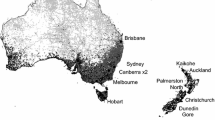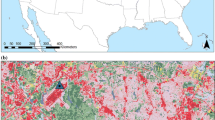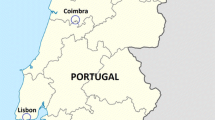Abstract
Historically in the East Midlands, UK, airborne pollen has been monitored in two cities, Derby and Leicester, situated 41 km (25 miles) apart. The aim of the present study was to compare aerobiological data from both sites to determine if a forecast based on data from one site would be sufficient for both, and to address the wider issue of reproducibility between geographically separated sites. Pollen types recorded could be split into two groups according to annual abundance, maximum daily concentration and the number of high count days. Six taxa made up the abundant group; ash, birch, grass, oak, nettle-type and yew-type, representing 90 and 88% of the total air spora for Derby and Leicester, respectively. Three consecutive years of grass and nettle pollen data are presented, supported by one year of abundant tree pollen data. There were highly significant positive correlations between the counts obtained. Line charts showing the average number of pollen grains m−3 air day−1 show similar trends, and Bland–Altman plots show little discrepancy between the amounts of pollen counted on any given day. Each day was classified according to the UK accepted threshold levels for grass. Weighted kappa statistics showed substantial or almost perfect agreement between the forecast classifications. With the caveat that this would not apply in a region with restrictions to air flow such as a mountain range or with extreme fluctuations such as a coastline site, this study suggests that data from a single site is suitable for forecasting a distance of up to 41 km.



Similar content being viewed by others
References
Adams-Groom, B., Emberlin, J., Corden, J., Millington, W., & Mullins, J. (2002). Predicting the start of the birch pollen season at London, Derby and Cardiff, United Kingdom, using a multiple regression model, based on data from 1987 to 1997. Aerobiologia, 18, 117–123.
Alcázar, P., Stach, A., Nowak, M., & Galán, C. (2009). Comparison of airborne herb pollen types in Córdoba (Southwestern Spain) and Poznan (Western Poland). Aerobiologia, 25, 55–63.
Andersen, T. B. (1991). A model to predict the beginning of the pollen season. Grana, 30, 269–275.
BAF. (1995). Airborne pollens and spores: A guide to trapping and counting. Worcester: British Aerobiology Federation (BAF).
Bland, J. M., & Altman, D. G. (1999). Measuring agreement in method comparison studies. Statistical Methods in Medical Research, 8, 135–160.
Caiola, M. G., Mazzitelli, A., Capucci, E., & Travaglini, A. (2002). Monitoring pollinosis and airborne pollen in a Rome university. Aerobiologia, 18, 267–275.
Clot, B. (2003). Trends in airborne pollen: An overview of 21 years of data in Neuchâtel (Switzerland). Aerobiologia, 19, 227–234.
Corden, J. M., & Millington, W. M. (1991). A study of Gramineae and Urticaceae pollen in the Derby area. Aerobiologia, 7, 100–106.
Corden, J., & Millington, W. (1999). A study of Quercus pollen in the Derby area, UK. Aerobiologia, 15, 29–37.
Corden, J., Millington, W., Bailey, J., Brookes, M., Caulton, E., Emberlin, J., et al. (2000). UK regional variations in Betula pollen (1993–1997). Aerobiologia, 16, 227–232.
Corden, J. M., Stach, A., & Millington, W. M. (2002). A comparison of Betula pollen seasons at two European sites; Derby, United Kingdom and Poznan, Poland (1995–1999). Aerobiologia, 18, 45–53.
D’Amato, G., Cecchi, L., Bonini, S., Nunes, C., Annesi-Maesano, I., Behrendt, H., et al. (2007). Allergenic pollen and pollen allergy in Europe. Allergy, 62, 976–990.
Davies, R. R., & Smith, L. P. (1973). Forecasting the start and severity of the hay fever season. Clinical Allergy, 3, 263–267.
Driessen, M. N. B. N., Van Herpen, R. M. A., & Smithuis, L. O. M. J. (1990). Prediction of the start of the grass pollen season for the southern part of the Netherlands. Grana, 29, 79–86.
Egger, C., Focke, M., Bircher, A. J., Scherer, K., Mothes-Luksch, N., Horak, F., et al. (2008). The allergen profile of beech and oak pollen. Clinical and Experimental Allergy, 38, 1688–1696.
Emberlin, J. C. (1997). Grass, tree and weed pollens. In A. B. Kay (Ed.) Allergy and allergic diseases (pp. 835–857). London: Blackwell Science.
Emberlin, J., Mullins, J., Corden, J., Jones, S., Millington, W., Brooke, M., et al. (1999). Regional variations in grass pollen seasons in the UK, long-term trends and forecast models. Clinical and Experimental Allergy, 29, 347–356.
Epton, M. J., Martin, I. R., Graham, P., Healy, P. E., Smith, H., Balasubramaniam, R., et al. (1997). Climate and aeroallergen levels in asthma: A 12 month prospective study. Thorax, 52, 528–534.
Eriksson, N. E. (1978). Allergy to pollen from different deciduous trees in Sweden. An investigation with skin tests, provocation tests and the radioallergosorbent test (RAST) in springtime hay fever patients. Allergy, 33, 299–309.
Fehér, Z., & Járai-Komlódi, M. (1997). An examination of the main characteristics of the pollen seasons in Budapest, Hungary (1991–1996). Grana, 36, 169–174.
Fountain, D. W., & Cornford, C. A. (1991). Aerobiology and allergenicity of Pinus radiata pollen in New Zealand. Grana, 30, 71–75.
Galán, C., Emberlin, J., Dominguez, E., Bryant, R. H., & Villamandos, F. (1995). A comparative analysis of daily variations in the Gramineae pollen counts at Cordoba, Spain and London, UK. Grana, 34, 189–198.
Hyde, H. A., & Adams, K. F. (1958). An atlas of airborne pollen grains. London: Macmillan.
Jäger, S. (2004). Europe. polleninfo.org. Home page at: http://www.polleninfo.org.
Jäger, S., Nilsson, S., Berggren, B., Pessi, A. M., Helander, M., & Ramfjord, H. (1996). Trends of some airborne tree pollen in the Nordic countries and Austria, 1980–1993. A comparison between Stockholm, Trondheim, Turku and Vienna. Grana, 35, 171–178.
Jato, V., Rodríguez-Rajo, F. J., Alcázar, P., de Nuntiis, P., Galán, C., & Mandrioli, P. (2006). May the definition of pollen season influence aerobiological results? Aerobiologia, 22, 13–25.
Katelaris, C. H., Burke, T. V., & Byth, K. (2004). Spatial variability in the pollen count in Sydney, Australia: Can one sampling site accurately reflect the pollen count for a region? Annals of Allergy Asthma & Immunology, 93, 131–136.
Keskin, O., Alyamac, E., Tuncer, A., Dogan, C., Adalioglu, G., & Sekerel, B. E. (2006). Do the leukotriene receptor antagonists work in children with grass pollen-induced allergic rhinitis? Pediatric Allergy and Immunology, 17, 259–268.
Lacey, M. E., & West, J. S. (2006). The air spora: A manual for catching and identifying airborne biological particles. Dordrecht: Springer.
Méndez, J., Comtois, P., & Iglesias, I. (2005). Betula pollen: One of the most important aeroallergens in Ourense, Spain. Aerobiological studies from 1993 to 2000. Aerobiologia, 21, 115–123.
Mirone, C., Albert, F., Tosi, A., Mocchetti, F., Mosca, S., Giorgino, M., et al. (2004). Efficacy and safety of subcutaneous immunotherapy with a biologically standardized extract of Ambrosia artemisiifolia pollen: A double-blind, placebo-controlled study. Clinical and Experimental Allergy, 34, 1408–1414.
Morrow Brown, H. M., & Jackson, F. A. (1978a). Aerobiological studies based in Derby. I. A simplified automatic volumetric spore trap. Clinical Allergy, 8, 589–597.
Morrow Brown, H. M., & Jackson, F. A. (1978b). Aerobiological studies based in Derby. III. A comparison of simultaneous pollen and spore counts from the east coast, Midlands and west coast of England and Wales. Clinical Allergy, 8, 611–619.
Pajno, G. B., Vita, D., Parmiani, S., Caminiti, L., La Grutta, S., & Barberio, G. (2003). Impact of sublingual immunotherapy on seasonal asthma and skin reactivity in children allergic to Parietaria pollen treated with inhaled fluticasone propionate. Clinical and Experimental Allergy, 33, 1641–1647.
Peeters, A. G. (2000). Frost periods and beginning of the ash (Fraxinus excelsior L.) pollen season in Basel (Switzerland). Aerobiologia, 16, 353–359.
Peternel, R., Srnec, L., Culig, J., Zaninović, K., Mitić, B., & Vukusić, I. (2004). Atmospheric pollen season in Zagreb (Croatia) and its relationship with temperature and precipitation. International Journal of Biometeorology, 48, 186–191.
Piotrowska, K. (2004). Comparison of Alnus, Corylus and Betula pollen counts in Lublin (Poland) and Skien (Norway). Annals of Agricultural and Environmental Medicine, 11, 205–208.
Rodriguez-Rajo, F. J., Dopazo, A., & Jato, V. (2004). Environmental factors affecting the start of pollen season and concentrations of airborne Alnus pollen in two localities of Galicia (NW Spain). Annals of Agricultural and Environmental Medicine, 11, 35–44.
Ross, A. M., Corden, J. M., & Fleming, D. M. (1996). The role of oak pollen in hay fever consultations in general practice and the factors influencing patients’ decisions to consult. British Journal of General Practice, 46, 451–455.
Smith, M., & Emberlin, J. (2005). Constructing a 7-day ahead forecast model for grass pollen at north London, United Kingdom. Clinical and Experimental Allergy, 35, 1400–1406.
Spieksma, F. Th. M., Corden, J. M., Detandt, M., Millington, W. M., Nikkels, H., Nolard, N., et al. (2003). Quantitative trends in annual totals of five common airborne pollen types (Betula, Quercus, Poaceae, Urtica, and Artemisia), at five pollen-monitoring stations in western Europe. Aerobiologia, 19, 171–184.
Taylor, P. E., Jacobson, K. W., House, J. M., & Glovsky, M. M. (2007). Links between pollen, atopy and the asthma epidemic. International Archives of Allergy and Immunology, 144, 162–170.
Vega-Maray, A. M., Valencia-Barrera, R. M., Fernández-González, D., & Fraile, R. (2003). Urticaceae pollen concentration in the atmosphere of North Western Spain. Annals of Agricultural and Environmental Medicine, 10, 249–255.
Viera, A. J., & Garrett, J. M. (2005). Understanding interobserver agreement: The kappa statistic. Family Medicine, 37, 360–363.
Acknowledgements
The authors are grateful to the Midlands Asthma and Allergy Research Association (MAARA) for providing the funding to carry out this study; to Mike Greenwood, Elizabeth Taylor and the rest of the team from the Faculty of Education Health and Sciences at the University of Derby for kindly changing the pollen traps; and to David Vince and Claire Barbour for providing weather data for Derby and Leicester, respectively.
Author information
Authors and Affiliations
Corresponding author
Rights and permissions
About this article
Cite this article
Pashley, C.H., Fairs, A., Edwards, R.E. et al. Reproducibility between counts of airborne allergenic pollen from two cities in the East Midlands, UK. Aerobiologia 25, 249–263 (2009). https://doi.org/10.1007/s10453-009-9130-x
Received:
Accepted:
Published:
Issue Date:
DOI: https://doi.org/10.1007/s10453-009-9130-x




